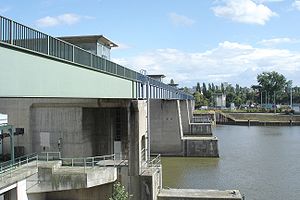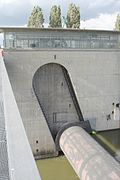Offenbach barrage
| Offenbach barrage | ||
|---|---|---|
| Offenbach barrage | ||
| location | ||
|
|
||
| Coordinates | 50 ° 6 '30 " N , 8 ° 43' 35" E | |
| country |
|
|
| place |
Frankfurt-Ostend Offenbach-Kaiserlei |
|
| Waters | Main | |
| Kilometers of water | km 38.43 | |
| power plant | ||
| construction time | 1949-1953 | |
| technology | ||
| Bottleneck performance | 4.1 megawatts | |
| Expansion flow | 180 m³ / s | |
| Standard work capacity | 22.7 million kWh / year | |
| Turbines | 2 Kaplan turbines | |
| Others | ||
The Offenbach barrage at kilometer 38.51 of the Main is a barrage with a lock . It lies on the city limits between Offenbach-Kaiserlei and Frankfurt-Ostend at the height of the Frankfurt East Harbor .
technology
The Offenbach barrage is a roller weir with two damming rollers and a dam. The weir width is three times 44.50 meters, the drop height is 3.18 meters with normal damming. The barrage has three lock chambers:
- the landside southern chamber with a usable length of 344.03 meters and a usable width of 12.09 meters, divisible by a third lock gate,
- the north chamber with 230.07 meters of usable length and 13.05 meters of usable width,
- an upstream boat lock with a usable length of 20.35 meters and a usable width of 3.50 meters.
The Main is classified in the European waterway class Vb and is navigable for ships or push convoys with a length of 185 meters and a width of 11.45 meters. The fairway is at least 2.90 meters deep all year round.
The hydropower of the Main is used by two Kaplan bulb turbines to generate electricity in a run-of-river power plant. It has a nominal output of 4,100 kilowatts with an additional flow rate of 180 m³ / s and serves to cover the base load . The systems in the generator house perform a standard work of 22.7 million kilowatt hours per year.
Pedestrians can cross the barrage on a three-meter-wide steel walkway that spans the Main on the weir pillars.
The barrage is equipped with a fish ladder , the placement of which, however, no longer corresponds to the current state of knowledge, as the fish collect at the power plant outlet on the opposite side of the Main due to the current and thus find the fish ladder very difficult.
history
The lower reaches of the Main between the estuary and Frankfurt was canalized from 1882 to 1885 in order to make the flat Main navigable for the ever larger Rhine ships. In Mainz-Kostheim , Flörsheim am Main , Okriftel , Höchst and Niederrad , five needle weirs with simple lock chambers were built in order to raise the mean waterway depth to 2.20 meters. At the same time, Frankfurt's West Harbor was created with a port basin suitable for ships on the Rhine. From 1927 the needle weirs were replaced by three more powerful roller weirs in Kostheim , Eddersheim and Griesheim with larger lock systems in order to cope with the increased volume of traffic on the Main.
In order to promote the canalization of the Main to Offenbach am Main , the Offenbach barrage was built between 1898 and 1900 as a needle weir. It had a lock basin and a raft slide . Plans by the Reich Waterways Administration from 1930 to replace the needle weir with a roller weir and new lock chambers were postponed in 1938 for financial reasons. The Offenbach barrage was only rebuilt between 1949 and 1953, and the inauguration took place in June 1953. In 1957, the system was expanded again to include a “self-propelled lock” and a boat lock. However, the boat lock was only able to go into operation in 1967 after its entrance threshold had been lowered below the level of the headwater.
As part of further expansion projects of the waterway Main, which from mid-1980 and the demolition of the above the main arch located barrage Mainkur and the construction of the barrage between Hanau-Kesselstadt and Mühlheim am Main included, was made the Offenbach barrage again powerful. The traffic jam was increased by 0.95 meters to a height of 3.18 meters in order to absorb the 2.35 meters of traffic jam that has now been eliminated in Mainkur.
In recent years, extensive renovation measures have been carried out on the barrage.
The barrage is part of the Route der Industriekultur Rhein-Main project in the Offenbach section .
literature
- Wolfram Gorr: Frankfurt bridges. Locks, ferries, tunnels and bridges of the Main. Frankfurter Societät, Frankfurt am Main 1982, ISBN 3-7973-0393-9
Web links
- Christian Wachter: Formerly a swamp, now a sluice: Offenbach barrage is one of many that make the Main constantly navigable. In: op-online.de . August 20, 2016. Retrieved August 22, 2016 .
- Offenbach barrage. In: Structurae
Individual evidence
- ↑ Local route guide No. 9 of the Route der Industriekultur Rhein-Main. (PDF; 519 kB) In: krfrm.de. KulturRegion FrankfurtRheinMain gGmbH, December 2005, accessed on November 14, 2015 .





